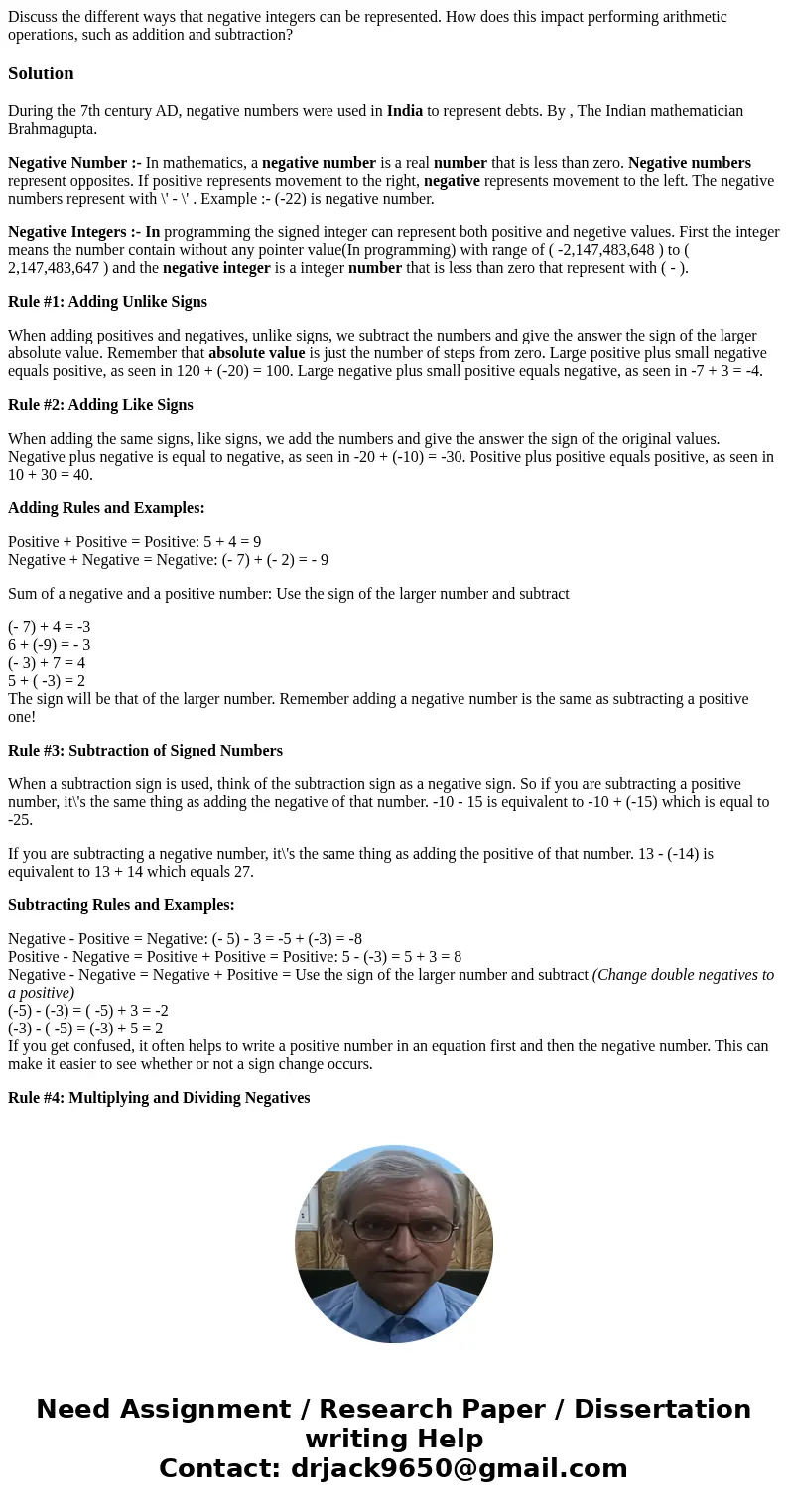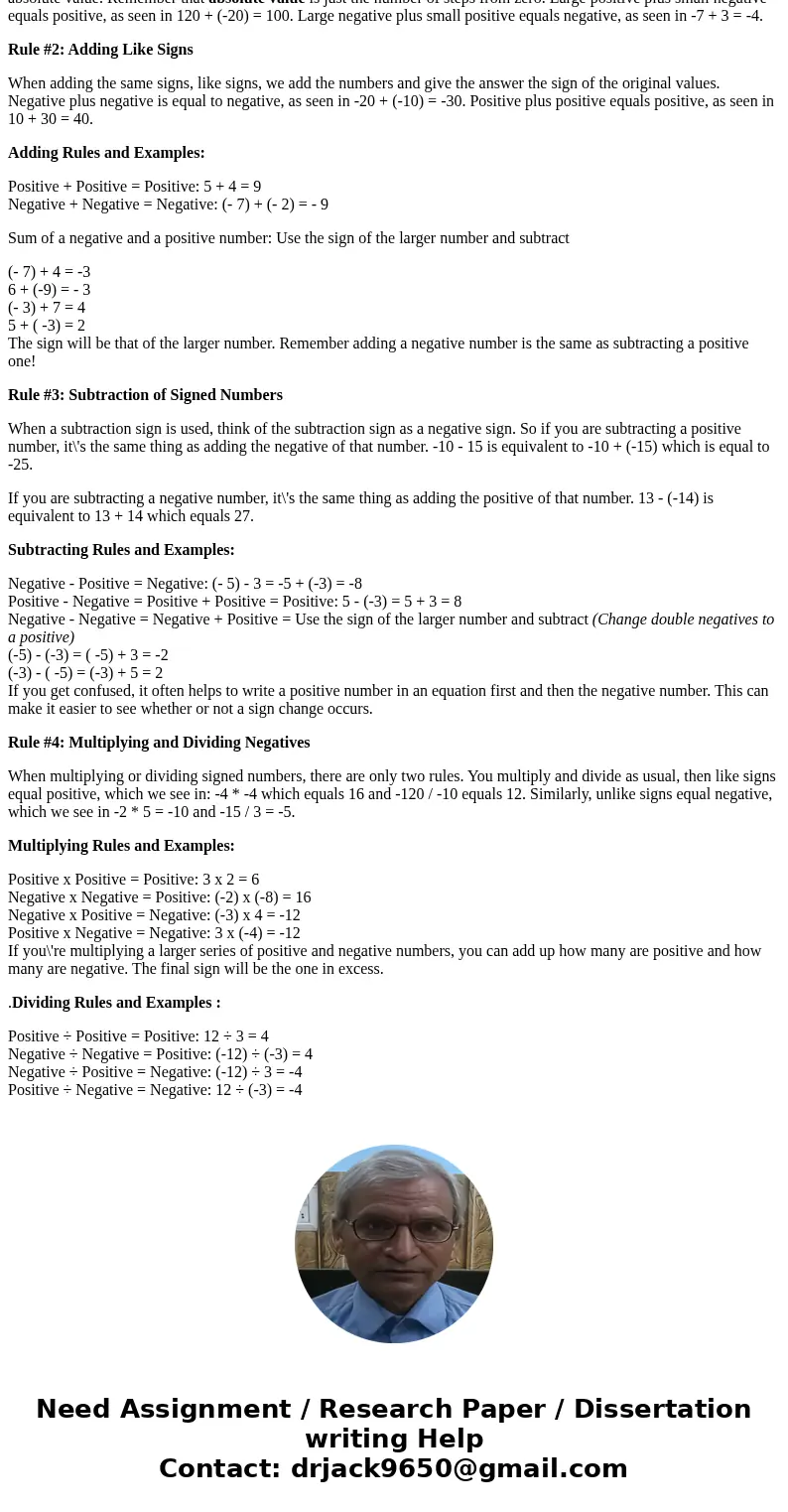Discuss the different ways that negative integers can be rep
Solution
During the 7th century AD, negative numbers were used in India to represent debts. By , The Indian mathematician Brahmagupta.
Negative Number :- In mathematics, a negative number is a real number that is less than zero. Negative numbers represent opposites. If positive represents movement to the right, negative represents movement to the left. The negative numbers represent with \' - \' . Example :- (-22) is negative number.
Negative Integers :- In programming the signed integer can represent both positive and negetive values. First the integer means the number contain without any pointer value(In programming) with range of ( -2,147,483,648 ) to ( 2,147,483,647 ) and the negative integer is a integer number that is less than zero that represent with ( - ).
Rule #1: Adding Unlike Signs
When adding positives and negatives, unlike signs, we subtract the numbers and give the answer the sign of the larger absolute value. Remember that absolute value is just the number of steps from zero. Large positive plus small negative equals positive, as seen in 120 + (-20) = 100. Large negative plus small positive equals negative, as seen in -7 + 3 = -4.
Rule #2: Adding Like Signs
When adding the same signs, like signs, we add the numbers and give the answer the sign of the original values. Negative plus negative is equal to negative, as seen in -20 + (-10) = -30. Positive plus positive equals positive, as seen in 10 + 30 = 40.
Adding Rules and Examples:
Positive + Positive = Positive: 5 + 4 = 9
Negative + Negative = Negative: (- 7) + (- 2) = - 9
Sum of a negative and a positive number: Use the sign of the larger number and subtract
(- 7) + 4 = -3
6 + (-9) = - 3
(- 3) + 7 = 4
5 + ( -3) = 2
The sign will be that of the larger number. Remember adding a negative number is the same as subtracting a positive one!
Rule #3: Subtraction of Signed Numbers
When a subtraction sign is used, think of the subtraction sign as a negative sign. So if you are subtracting a positive number, it\'s the same thing as adding the negative of that number. -10 - 15 is equivalent to -10 + (-15) which is equal to -25.
If you are subtracting a negative number, it\'s the same thing as adding the positive of that number. 13 - (-14) is equivalent to 13 + 14 which equals 27.
Subtracting Rules and Examples:
Negative - Positive = Negative: (- 5) - 3 = -5 + (-3) = -8
Positive - Negative = Positive + Positive = Positive: 5 - (-3) = 5 + 3 = 8
Negative - Negative = Negative + Positive = Use the sign of the larger number and subtract (Change double negatives to a positive)
(-5) - (-3) = ( -5) + 3 = -2
(-3) - ( -5) = (-3) + 5 = 2
If you get confused, it often helps to write a positive number in an equation first and then the negative number. This can make it easier to see whether or not a sign change occurs.
Rule #4: Multiplying and Dividing Negatives
When multiplying or dividing signed numbers, there are only two rules. You multiply and divide as usual, then like signs equal positive, which we see in: -4 * -4 which equals 16 and -120 / -10 equals 12. Similarly, unlike signs equal negative, which we see in -2 * 5 = -10 and -15 / 3 = -5.
Multiplying Rules and Examples:
Positive x Positive = Positive: 3 x 2 = 6
Negative x Negative = Positive: (-2) x (-8) = 16
Negative x Positive = Negative: (-3) x 4 = -12
Positive x Negative = Negative: 3 x (-4) = -12
If you\'re multiplying a larger series of positive and negative numbers, you can add up how many are positive and how many are negative. The final sign will be the one in excess.
.Dividing Rules and Examples :
Positive ÷ Positive = Positive: 12 ÷ 3 = 4
Negative ÷ Negative = Positive: (-12) ÷ (-3) = 4
Negative ÷ Positive = Negative: (-12) ÷ 3 = -4
Positive ÷ Negative = Negative: 12 ÷ (-3) = -4


 Homework Sourse
Homework Sourse